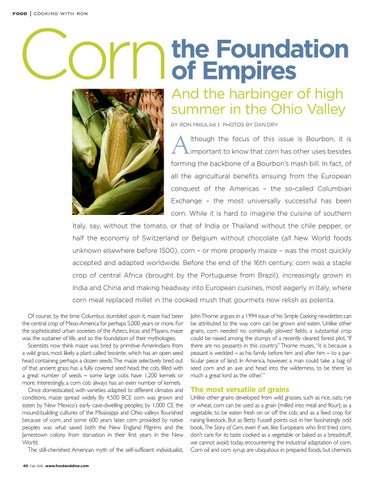food | cooking with ron
Corn
the Foundation of Empires And the harbinger of high summer in the Ohio Valley BY RON MIKULAK | PHOTOS BY DAN DRY
A
lthough the focus of this issue is Bourbon, it is important to know that corn has other uses besides
forming the backbone of a Bourbon’s mash bill. In fact, of all the agricultural benefits ensuing from the European conquest of the Americas – the so-called Columbian Exchange – the most universally successful has been corn. While it is hard to imagine the cuisine of southern Italy, say, without the tomato, or that of India or Thailand without the chile pepper, or half the economy of Switzerland or Belgium without chocolate (all New World foods unknown elsewhere before 1500), corn – or more properly maize – was the most quickly accepted and adapted worldwide. Before the end of the 16th century, corn was a staple crop of central Africa (brought by the Portuguese from Brazil), increasingly grown in India and China and making headway into European cuisines, most eagerly in Italy, where corn meal replaced millet in the cooked mush that gourmets now relish as polenta. Of course, by the time Columbus stumbled upon it, maize had been the central crop of Meso-America for perhaps 5,000 years or more. For the sophisticated urban societies of the Aztecs, Incas and Mayans, maize was the sustainer of life, and so the foundation of their mythologies. Scientists now think maize was bred by primitive Amerindians from a wild grass, most likely a plant called teosinte, which has an open seed head containing perhaps a dozen seeds. The maize selectively bred out of that ancient grass has a fully covered seed head, the cob, filled with a great number of seeds – some large cobs have 1,200 kernels or more. Interestingly, a corn cob always has an even number of kernels. Once domesticated, with varieties adapted to different climates and conditions, maize spread widely. By 4,500 BCE corn was grown and eaten by New Mexico’s early cave-dwelling peoples; by 1,000 CE the mound-building cultures of the Mississippi and Ohio valleys flourished because of corn, and some 600 years later, corn provided by native peoples was what saved both the New England Pilgrims and the Jamestown colony from starvation in their first years in the New World. The still-cherished American myth of the self-sufficient individualist, 40 Fall 2016 www.foodanddine.com
John Thorne argues in a 1994 issue of his Simple Cooking newsletter, can be attributed to the way corn can be grown and eaten. Unlike other grains, corn needed no continually plowed fields; a substantial crop could be raised among the stumps of a recently cleared forest plot. “If there are no peasants in this country,” Thorne muses, “it is because a peasant is wedded – as his family before him and after him – to a particular piece of land. In America, however, a man could take a bag of seed corn and an axe and head into the wilderness, to be there ‘as much a great lord as the other.’ ”
The most versatile of grains Unlike other grains developed from wild grasses, such as rice, oats, rye or wheat, corn can be used as a grain (milled into meal and flour); as a vegetable, to be eaten fresh on or off the cob; and as a feed crop for raising livestock. But as Betty Fussell points out in her fascinatingly odd book, The Story of Corn, even if we, like Europeans who first tried corn, don’t care for its taste cooked as a vegetable or baked as a breadstuff, we cannot avoid, today, encountering the industrial adaptation of corn. Corn oil and corn syrup are ubiquitous in prepared foods, but chemists
